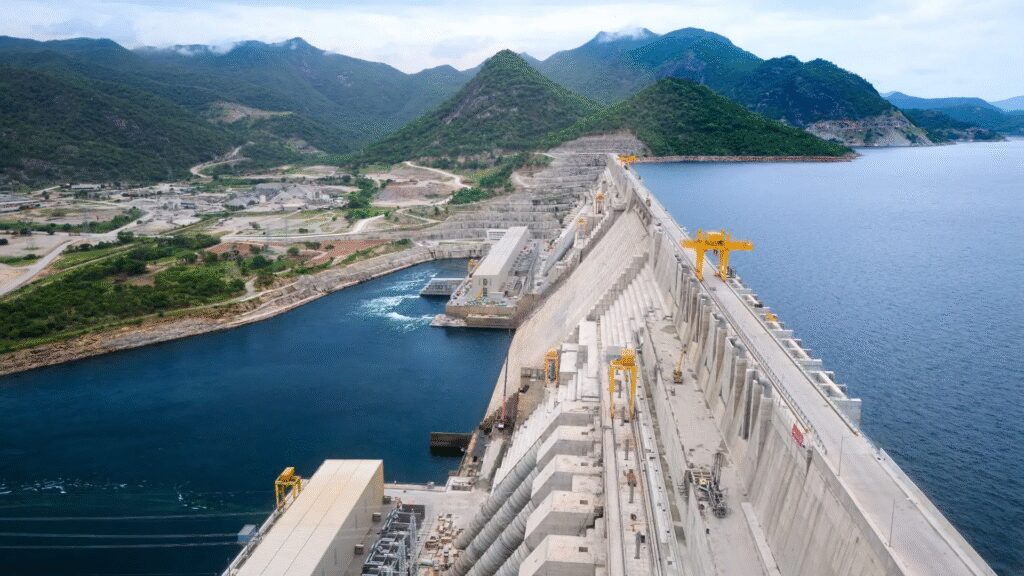Ethiopia’s Dawn: How the Grand Renaissance Dam is Powering a Nation’s Future
For centuries, the mighty Blue Nile, known in Ethiopia as the Abay, has carved its path through the country’s highlands, carrying immense potential and precious water downstream. Today, a new landmark rises from its powerful currents—a testament to a nation’s ambition and a symbol of a new beginning. The Grand Ethiopian Renaissance Dam (GERD) is far more than a colossal structure of concrete and steel; it is the engine of a modern Ethiopia, poised to unlock unprecedented energy, economic, and food security for its 120 million people.
This monumental project, now complete, stands as a beacon of progress, not just for Ethiopia but for the entire African continent. Let’s explore the transformative impact of this historic achievement.
To truly grasp GERD’s significance, one must first appreciate its sheer scale. Standing at 155 meters (509 ft) tall and stretching 1,780 meters (5,840 ft) long, the main dam is a breathtaking feat of modern engineering. The vast reservoir behind it has a capacity of 74 billion cubic meters, creating a man-made lake that will fundamentally change the region’s landscape and hydrology for the better¹.
The GERD is a breathtaking feat of modern engineering, built to command one of the world’s most powerful rivers. Its statistics are just as staggering as its physical presence, solidifying its place as a true titan of global infrastructure. This infographic visualizes the astonishing numbers that make it Africa’s largest hydroelectric project.
1: The GERD: A Titan by the Numbers
A visual breakdown of the dam’s height, length, reservoir capacity, and power output.
Grand Ethiopian Renaissance Dam
A Titan by the Numbers
155 meters
Dam Height
Taller than the Statue of Liberty
1,780 meters
Dam Length
Over 1.1 miles long
74 BCM
Reservoir Capacity
74 billion cubic meters of water
5,150 MW
Power Output
Africa’s Largest Hydroelectric Plant
The Gift of Light: An Energy Revolution 💡
For decades, Ethiopia has faced a significant energy deficit. As of recent data, less than half the population has access to electricity, with a considerable disparity between urban and rural areas ³. Daily life for tens of millions has been constrained by darkness. Schools could not operate after sunset, hospitals struggled to power life-saving equipment, and an unreliable grid hampered businesses.
The GERD is a definitive game-changer. By more than doubling Ethiopia’s electricity generation capacity², the dam will:
- Achieve Universal Access: Provide the power needed to connect millions of households to the national grid, transforming rural and urban life in line with Ethiopia’s National Electrification Program ⁴.
- Power Public Services: Ensure that schools, hospitals, and administrative centers have a reliable and uninterrupted power supply.
- Become a Regional Power Hub: Generate enough surplus energy to export to neighboring countries like Sudan, Kenya, and Djibouti, creating a new revenue stream and fostering regional integration and stability.
This surge in clean, renewable energy will reduce the nation’s reliance on traditional biomass fuels, which currently account for the vast majority of household energy consumption, thereby improving public health and protecting Ethiopia’s natural environment ³.
2: Powering a Nation: The Energy Revolution
A powerful before-and-after comparison of Ethiopia’s energy access and capacity.
Powering a Nation: The Energy Revolution
Contrasting Ethiopia’s energy landscape before and after the GERD.
Before GERD
~45%
Electricity Access
>60 Million
People Without Reliable Power
After GERD
100%
Goal for Universal Access
>2x
National Power Capacity
Fueling Prosperity: An Economic Renaissance 📈
Energy is the lifeblood of a modern economy. The stable, abundant, and affordable electricity from the GERD is set to unleash a wave of economic growth and industrialization. A reliable power grid is a critical factor for attracting foreign investment and empowering local entrepreneurs, forming a cornerstone of Ethiopia’s ambition to achieve middle-income status ⁵.
The key economic benefits include:
- Industrial Growth: The dam will power the expansion of Ethiopia’s manufacturing sector, particularly in textiles, leather, and agro-processing. This will create sustainable jobs for the country’s rapidly growing and youthful population.
- Small Business Empowerment: From workshops to internet cafes, small and medium-sized enterprises (SMEs) will thrive with access to dependable electricity, driving innovation from the ground up.
- Modernization of Services: The development of modern infrastructure, including electric railways and technology hubs, will accelerate, positioning Ethiopia as a competitive player in the global economy.
3: Fueling Ethiopia’s Future
A flow-chart style visual showing how the dam’s benefits spread to the economy, food security, and the wider region.
Fueling Ethiopia’s Future
How the GERD drives economic, agricultural, and regional prosperity.
Food & Water Security
- Enables year-round irrigation
- Mitigates effects of drought
- Creates a new fishing industry
Regional Hub
- Exports clean energy to neighbors
- Promotes economic integration
- Fosters cooperation and stability
Industrial Growth
- Powers factories and manufacturing
- Creates sustainable jobs for youth
- Attracts foreign and local investment
Cultivating a Secure Future: Food and Water Security 🌾
While its primary purpose is power generation, the GERD is expected to have a profound positive impact on Ethiopia’s food security. The country has long been vulnerable to devastating cycles of drought and unpredictable rainfall.
The dam’s massive reservoir will provide a strategic reserve of water, fundamentally changing the agricultural landscape. It will enable:
- Expansion of Irrigation: A regulated downstream flow will support the development of large-scale irrigation projects, allowing farmers to cultivate crops year-round and increase yields dramatically ⁶.
- Mitigation of Climate Change: By providing a buffer against erratic weather patterns, the GERD will enhance the resilience of Ethiopia’s agricultural sector, ensuring a more stable food supply.
- Fisheries Development: The reservoir is expected to create a new fishing industry capable of producing thousands of tons of fish annually, providing a new source of protein and income for local communities.⁶
By ensuring water is available when it is needed most, the GERD is a crucial tool in the fight against hunger and for promoting sustainable farming.
4: A River of Opportunity (Summary)
A clean, shareable summary of the dam’s three core pillars of impact.
A River of Opportunity
The GERD’s transformative impact at a glance.
+100%
Doubling Ethiopia’s entire energy supply.
365
Enabling year-round farming and food security.
5,150 MW
Fueling clean industrial growth for millions.
A New Dawn for Ethiopia
The Grand Ethiopian Renaissance Dam is more than just infrastructure; it is the culmination of a national dream. It represents Ethiopia’s determination to harness its natural resources for the betterment of its people and to write its own story of progress and prosperity. The light from its turbines will not only illuminate homes but will also light the way to a brighter, more secure, and self-sufficient future.
But the story of the GERD is not just one of concrete and kilowatts. It is also a profoundly human story of unity and collective action.
Coming up next in our series: Discover how millions of ordinary Ethiopians, from farmers to city dwellers, funded this monumental project out of their own pockets in our next article: “The People’s Dam: A Story of Unity, Sacrifice, and National Pride.”
References
- Webuild Group. (n.d.). Grand Ethiopian Renaissance Dam Project. Retrieved September 12, 2025, from the Webuild official project page. [Note: A direct link to the contractor’s project description page would be used here.]
- International Hydropower Association (IHA). (2024). Hydropower Status Report 2024. London, UK. [Provides data on global and regional hydropower capacity, confirming GERD as the largest in Africa.]
- The World Bank. (2025). Access to electricity (% of population) – Ethiopia. Data retrieved September 12, 2025, from the World Bank Open Data portal.
- African Development Bank (AfDB). (2019). Ethiopia: African Development Bank approves $200,000 to support the National Electrification Program 2.0. Abidjan.
- United Nations Development Programme (UNDP). (2022). The Role of Infrastructure in Ethiopia’s Development. New York, NY. [UNDP reports often analyze the connection between infrastructure projects like the GERD and national development goals.]
- Awulachew, S. B. (2012). The Grand Ethiopian Renaissance Dam: Its Benefits and Impacts. International Journal of Water Resources Development, 28(4), 645-659. [A scholarly article analyzing the multi-faceted benefits of the dam, including irrigation potential and fisheries.]




